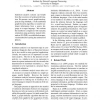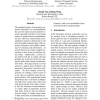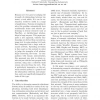COLING
2010
13 years 7 months ago
2010
Sentiment analysis systems can benefit from the translation of sentiment information. We present a novel, graph-based approach using SimRank, a well-established graph-theoretic al...
COLING
2010
13 years 7 months ago
2010
Choosing the right parameters for a word sense disambiguation task is critical to the success of the experiments. We explore this idea for prepositions, an often overlooked word c...
COLING
2010
13 years 7 months ago
2010
Studies of discourse relations have not, in the past, attempted to characterize what serves as evidence for them, beyond lists of frozen expressions, or markers, drawn from a few ...
COLING
2010
13 years 7 months ago
2010
This paper is a case study on cross-lingual induction of lexical resources for deep, broad-coverage syntactic analysis of German. We use a parallel corpus to induce a classifier f...
COLING
2010
13 years 7 months ago
2010
This paper presents a comparative study on two key problems existing in extractive summarization: the ranking problem and the selection problem. To this end, we presented a system...
COLING
2010
13 years 7 months ago
2010
Tibetan word segmentation is essential for Tibetan information processing. People mainly use the basic machine matching method which is based on dictionary to segment Tibetan word...
COLING
2010
13 years 7 months ago
2010
We describe a new information fusion approach to integrate facts extracted from cross-media objects (videos and texts) into a coherent common representation including multi-level ...
COLING
2010
13 years 7 months ago
2010
Hindi and Urdu share a common phonology, morphology and grammar but are written in different scripts. In addition, the vocabularies have also diverged significantly especially in ...
COLING
2010
13 years 7 months ago
2010
The potential benefit of integrating contextual information for recommendation has received much research attention recently, especially with the ever-increasing interest in mobil...
COLING
2010
13 years 7 months ago
2010
Humans are very good at judging the strength of relationships between two terms, a task which, if it can be automated, would be useful in a range of applications. Systems attempti...



